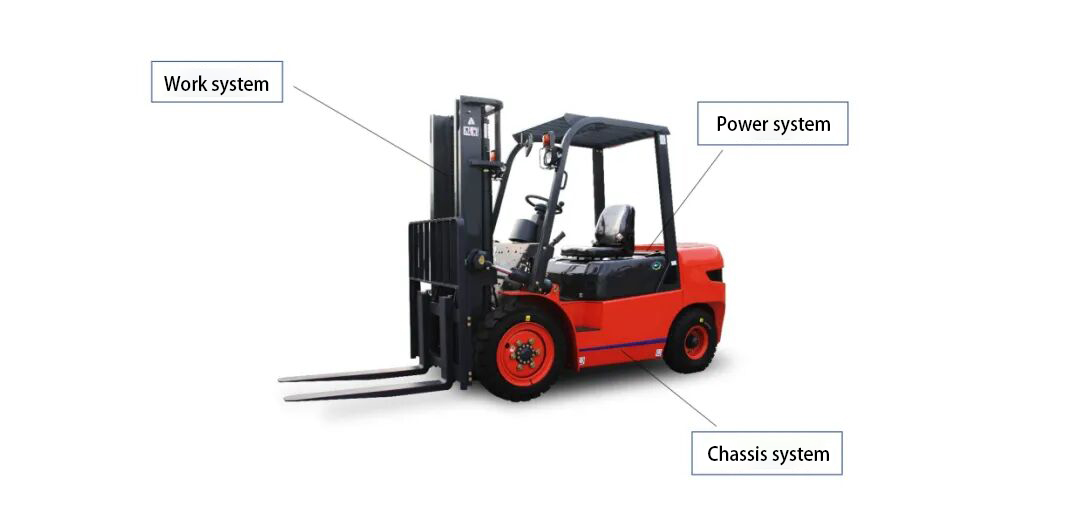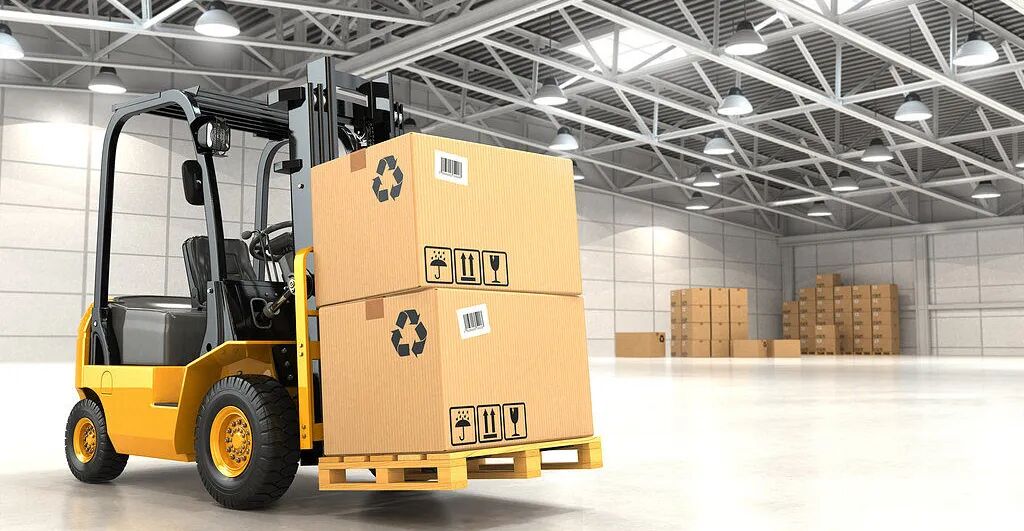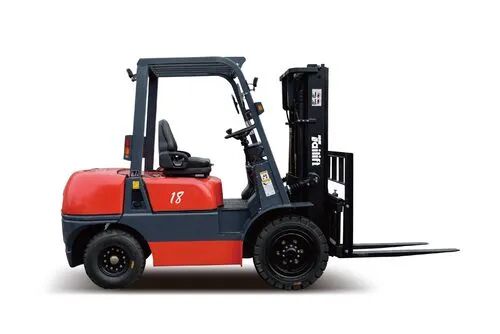A forklift is a type of industrial machinery designed for lifting and stacking goods. It is widely used in warehousing, logistics, and manufacturing. Comprising numerous distinct components, each serving a specific function, the forklift works as an integrated system to perform its tasks efficiently. Typically, an internal combustion forklift consists of three main sections: the power unit, the chassis, and the lifting assembly.

1 Power Unit
The power unit in an internal combustion forklift comprises the power system and the electrical system.
The power system can be broadly categorized into gasoline, diesel, and LPG (Liquefied Petroleum Gas) engines.
Standard internal combustion forklifts may use any of these three engine types. In contrast, rough-terrain forklifts typically employ diesel engines for their robustness, while electric forklifts utilize a combination of batteries and an electric motor as their power source.
2 Chassis
The forklift chassis comprises four main systems: the transmission system, the running gear, the steering system, and the braking system.
01 Transmission System
The transmission system in forklifts comes in various types, including mechanical, hydro-mechanical, and hydrostatic. Mechanical transmissions are more common in small forklifts, while medium and large models predominantly use hydro-mechanical systems. Rough-terrain forklifts typically employ hydrostatic transmission.
02 Running Gear
The running gear consists of the frame, suspension, operator cabin, and overhead guard. It connects all assemblies and components into a unified structure, supports the total weight, absorbs vibrations, cushions impacts, and transmits various forces and torques. Frames are categorized as rigid or articulated. Standard forklifts usually feature a rigid frame, whereas rough-terrain models often use an articulated frame.
03 Steering System
Forklift steering systems include mechanical, hydraulic power-assisted, and full hydraulic types. With advancements in technology, most modern forklifts now utilize hydraulic power-assisted or full hydraulic steering.
04 Braking System
Braking systems vary and can be mechanical, hydraulic, vacuum-boosted hydraulic, or air/pneumatic. Hydraulic brakes are standard on small and medium-sized forklifts. Larger models frequently use vacuum-boosted hydraulic systems, and rough-terrain forklifts are commonly equipped with air brakes.
3 Working Assembly
The working assembly of a forklift comprises three primary systems: the Mast System, the Hydraulic System, and the Attachment System.
01 Mast System
The mast system is the key mechanism that distinguishes forklifts from other types of engineering machinery. It generally consists of inner and outer masts, a fork carriage, forks, lift chains, lift cylinders, and tilt cylinders. This assembly bears the total weight of the load and executes operations such as picking up, transporting, lifting, lowering, and stacking or destacking goods.
The hydraulic system typically includes a hydraulic pump, cylinders, directional control valves, flow dividers, hydraulic fluid, and a reservoir. It transmits power via the hydraulic fluid to actuate the mast system, thereby facilitating the loading and unloading of materials.
03 Attachment System
Driven by technological advancement and the continuous pursuit of operational efficiency, specialized forklift attachments have seen growing adoption and now come in a wide variety. These attachments can generally be classified into types for lateral movement, rotation, vertical movement, and those designed specifically for handling particular goods. This system greatly expands the functional scope of forklifts and substantially enhances the efficiency of material handling and logistics operations.
Furthermore, the forklift includes the operator cabin and control panel.The cabin provides a comfortable and secure working environment for the operator, typically equipped with a seat, steering wheel, and pedals. The control panel features various buttons and indicator lights, allowing the operator to manage key functions such as starting, stopping, accelerating, changing speed, and braking.

Finally, forklifts are equipped with multiple safety devices to ensure workplace safety.These include speed limiters, seat belts, rollover protective structures (ROPS), and warning alarms. The speed limiter restricts travel speed to prevent accidents. Seat belts protect the operator from potential injuries. ROPS helps maintain stability and prevent tipping when handling heavy loads. Warning alarms alert nearby personnel to the presence of the forklift, reducing the risk of collisions.
In summary, a forklift is a complex machine composed of multiple specialized components. Each part plays a vital role in enabling the forklift to perform various material handling and stacking tasks efficiently. Proper use and maintenance of these components are essential to ensure operational safety, stability, and productivity.
Commonly Worn-Out Parts in Forklifts
Forklifts are essential equipment for moving heavy loads and are widely used in warehouses and logistics centers. However, due to their intensive usage cycles and the heavy loads they bear, various components are prone to failure and wear.

1. Wheels / Tires
Forklift tires bear the entire weight of the equipment and endure repeated compression forces during operation, making them highly prone to wear and damage. Traveling across varied surfaces—including indoor floors, outdoor terrain, and uneven ground—accelerates tire wear. Additionally, sharp edges on handled loads can cause cuts, tears, and other physical damage to the tires.
2. Braking System
The brakes are a critical safety system. Key components such as brake pads, discs (or drums), and hydraulic lines are subject to wear, corrosion, and fatigue over time. This degradation directly compromises braking performance and stopping power, posing a serious risk not only to the operator but also to nearby personnel and equipment.
3. Battery
In electric forklifts, the battery is the primary power source. However, batteries are susceptible to damage from overcharging, deep discharging, vibration, and improper maintenance. Battery issues result in shortened operating hours, reduced performance, and can ultimately lead to complete operational failure.
4. Hydraulic System
The hydraulic system, including the reservoir, pump, cylinders, and valves, operates under high pressure, temperature, and frequent cycling. These conditions make it vulnerable to leaks, seal degradation, and general wear. Since the hydraulic cylinders constantly bear heavy loads during lifting and lowering, they are especially prone to leakage or damage over time, causing a loss of lifting capacity or instability.
5. Electrical System
The internal wiring and circuits control vital functions like drive motors, lighting, and sensors. Prolonged use and exposure to harsh conditions can cause wiring insulation to crack, connectors to corrode, and components to short-circuit or fail. Such electrical faults can lead to a partial or complete loss of control over the forklift's functions.
6. Lift Chains and Sprockets
Located within the mast assembly, the lift chains and sprockets are responsible for raising and lowering the load. Continuous use leads to chain stretch, wear on individual links, and sprocket tooth deformation. This wear negatively impacts lifting efficiency, smooth operation, and overall load-handling safety.
The parts listed above represent only some of the common wear items on a forklift. Beyond these, a forklift comprises numerous other components—such as the transmission system, steering system, and operator cabin—that also require regular inspection and maintenance to ensure safe and efficient operation.
The specific wear parts needed can vary depending on the type of forklift. Therefore, to prevent potential failures, it is essential for users to implement a consistent schedule of maintenance, care, and inspection. Any identified issues should be addressed promptly through repair or part replacement to guarantee the forklift's reliable performance and the safety of the operator.
Should you require any forklift parts, please do not hesitate to contact us!